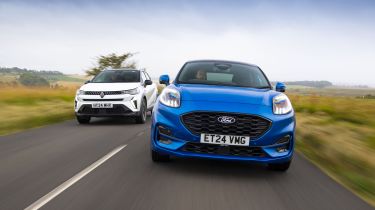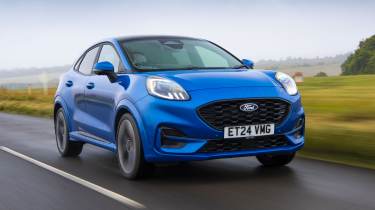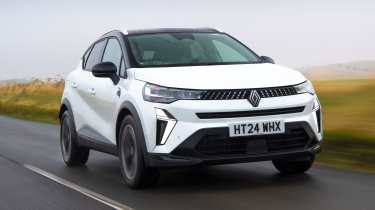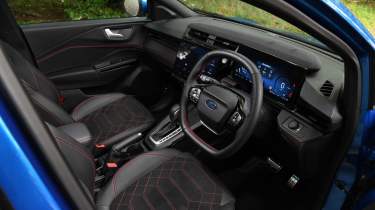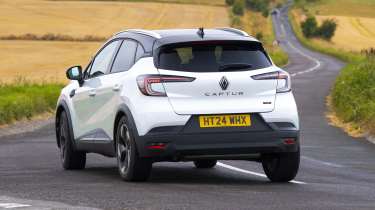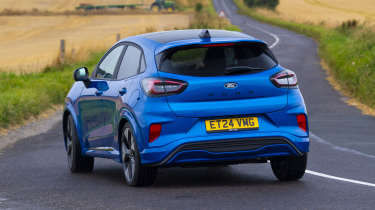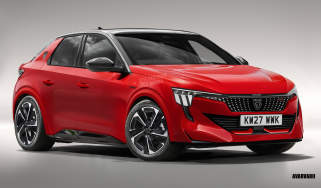Ford Puma vs Renault Captur: the big small-SUV showdown
Ford and Renault freshen up its offerings in key new-car segment
After a couple of years away from the limelight, 2023 saw a Ford return to the top of the UK new-car sales charts. It was always going to be a tough task to follow in the footsteps of the once-dominant Fiesta, but since the hatchback’s demise, its SUV-based relative, the Ford Puma, has managed to wrestle the crown back from the competition.
If 2024’s figures continue the way they are, the Puma is going to hold the title of Britain’s best-selling model two years running, too. Thanks to a mid-life facelift, there’s every chance that customers will keep flocking to their nearest Ford dealer in their thousands. But the standard of competition is sky high in this segment. Even if the Puma maintains its stranglehold on sales, some of the Ford’s less popular alternatives have the talent to compete with it as an all-round package.
Here, the new Puma is facing off against the Renault Captur. The latter is a multiple Auto Express award winner, with the latest version delivering a blend of talent and value that most rivals struggle to match. The Captur has also been refreshed for 2024, so which car has received the more significant changes, and which makes the better buy overall?
Ford Puma
| Model: | Ford Puma EcoBoost mHEV Titanium |
| Price: | £26,700 |
| Powertrain: | 1.0-litre 3cyl petrol MHEV, 123bhp |
| 0-62mph: | 9.8 seconds |
| Efficiency (WLTP): | 52.3mpg |
| Official range: | 483 miles |
| Annual VED: | £180 |
Ford turned up fairly late to the small SUV party, with the Puma being launched in 2019, the same year that Renault released the second-generation Captur that it’s competing against here.
More reviews
Car group tests
In-depth reviews
Road tests
- New Ford Puma facelift 2024 review: best-selling SUV gets welcome upgrades
- New Ford Puma ST Powershift 2023 review
- New Ford Puma ST-Line X Gold Edition 2022 review
Used car tests
But Ford has wasted no time in turning its offering in this class into a sales success. With nearly 50,000 units sold in the UK last year, the Puma comfortably beat the next two most popular models in the segment, the Nissan Juke (31,745 units sold) and Vauxhall Mokka (29,984).
Testers' notes
- With a chassis that’s so good, it’s a massive shame that the Puma’s automatic gearbox can’t keep up. It’s very slow to kick down, and even when in Sport mode it’ll often stay in a ratio or two that’s too high when you are exiting a turn.
- Worse still is that there’s no way to work around it, because there aren’t any steering-wheel mounted paddles for manual changes. Family car drivers who are looking for a little bit of fun should definitely go for one of the manual models, which have a sweet-shifting gearbox.
Renault Captur
| Model: | Renault Captur E-Tech hybrid Techno |
| Price: | £21,095 |
| Powertrain: | 1.6-litre 4cyl petrol hybrid, 143bhp |
| 0-62mph: | 10.6 seconds |
| Efficiency (WLTP): | 60.1mpg |
| Official range: | 635 miles |
| Annual VED: | £180 |
Under the skin, the Captur uses the same Renault-Nissan CMF-B platform as the Nissan Juke. But while that car looks more distinctive, the French brand produced a better, more rounded package.
Renault has made the most of the Captur’s modest 4.2-metre long dimensions. It’s almost exactly the same length as a Volkswagen Golf, but it’s much more spacious. A modern infotainment set-up aims to address one of the slightly negative aspects of the pre-facelift car.
Testers' notes
- Each of the Renault’s three trims gets different wheel sizes; 17-inch items for the Evolution, an inch larger for Techno and 19 inches for Esprit Alpine. While the latter looks very sharp, one unwanted side effect is that the ride becomes less relaxing, which takes the shine off one of the Renault’s strengths. That’s why we prefer the Techno.
- The same complaint applies to the Puma, only more so; a mix of sports suspension and large wheels might make the ST-Line X irritating for some, which is why we like the base-spec Titanium.
Head-to-head
On the road
These cars behave very differently from behind the wheel. The Ford feels agile and sporty, while the Renault is more like a soft SUV. The Puma is great fun on a twisty road, but the Captur soaks up bumps better and has less road noise at higher speeds. The Ford’s mild-hybrid set-up is at its best with a manual gearbox, while the Renault’s full
Tech highlights
Ford offers two mild-hybrid versions of its 1.0-litre EcoBoost engine with the Puma. The Renault has a non-hybrid 89bhp petrol that feels underpowered. We’d go for the full hybrid, which has a 1.6-litre petrol engine and a pair of e motors. These each provide two of the gearbox’s six speeds; the others are provided by a ‘dog box’ arrangement.
Price and running
Renault offers superb finance deals across its range, and the Captur is a bargain, with a zero per cent PCP offered on a two-year contract. With a hefty £7,900 deposit, you can get an E-Tech Hybrid in Techno trim on a 9,000-mile annual limit for £214 a month. The Puma Titanium mHEV manual and auto cars come to £233 and £265 per month respectively on matching terms.
Practicality
Both cars are fairly roomy by compact-SUV standards. The Renault has a slight edge for passenger room, but not boot space (422 versus 456 litres in the Puma’s favour). The Ford’s superbly designed hose-down Megabox underfloor storage is a very handy feature. But rear headroom is compromised in Pumas with the optional panoramic sunroof.
Safety
These models have very similar safety kit, with all versions of each getting lane-keep assist, cruise control and rear parking sensors. Yet the Puma’s four-star Euro NCAP rating can’t beat the Renault’s full five stars. Its adult-occupant protection score of 75 per cent trails the Captur’s 96 per cent, but it was tested three years earlier to slightly less stringent standards.
Ownership
Little separates this pair on warranty packages and customer satisfaction. Ford ranked 30th overall out of 32 brand in our 2024 Driver Power survey, with Renault 28th. Both cars have a three-year, 60,000-mile warranty, which is beaten by Korean rivals’ five to seven-year packages. The Renault gets three years of breakdown cover; two years longer than the Ford’s.
Verdict
First place: Renault Captur
The Mk2 Renault Captur immediately became a hit in this segment, and the latest updates have freshened up a car that was still among the class leaders five years after its arrival.
It wins here because it’s more than a match for the Puma in all the key areas; it’s a bit more spacious and comfortable, plus it boasts sharper infotainment tech. Most importantly, it’s kinder on the owner’s bank balance. Not only is it more fuel efficient in the real world, but it’s also cheaper to finance by some margin – especially at the lower end of the range.
Second place: Ford Puma
While the Ford Puma is the most popular car in its class by far, this contest proves that it isn’t quite the best overall package. There are lots of good reasons to buy one, though, most notably its fantastic driving dynamics and smart touches that boost its practicality.
The new infotainment system is a clear improvement, while the Ford matches the Renault for space and in-car tech, but the Captur offers savings when it comes to monthly finance and running costs. The Puma is still a great car – just not quite a class leader.
Prices and specs
| FORD PUMA | RENAULT CAPTUR | |
| Our choice | EcoBoost mHEV Titanium | E-Tech hybrid Techno |
| Price from/price of our choice | £26,700/£26,700 | £21,095/£26,295 |
| POWERTRAIN AND PERFORMANCE | ||
| Engine | 3cyl in-line/999cc | 4cyl in-line/1,598cc |
| HEV Motor | 48-volt MHEV | 2x e-motors |
| Power | 123bhp | 143bhp |
| Torque | 170Nm | 250Nm |
| Transmission | Six-speed auto/fwd | Six-speed auto/fwd |
| 0-62mph/top speed | 9.8 seconds/119mph | 10.6 seconds/106mph |
| Fuel tank/ battery capacity | 42 litres/0.48kWh | 48 litres/1.2kWh |
| MPG (WLTP)/range | 52.3mg/483 miles | 60.1mpg/635 miles |
| CO2 emissions | 121g/km | 105g/km |
| DIMENSIONS | ||
| Length/wheelbase | 4,186/2,588mm | 4,239/2,639mm |
| Width/height | 1,805/1,536mm | 1,797/1,575mm |
| Rear kneeroom | 605-855mm | 664-825mm |
| Rear headroom/elbow room | 848mm (w/sunroof)/1,381mm | 912/1,404mm |
| Boot space (seats up/down) | 456/1,216 litres | 422/1,596 litres |
| Boot length/width | 725/1,000mm | 670/1,026mm |
| Boot lip height | 765mm | 772mm |
| Kerbweight/max braked towing weight | 1,316/1,100kg | 1,483/750kg |
| Turning circle | 10.4 metres | 11.1 metres |
| COSTS/OWNERSHIP | ||
| Residuals (3yrs/36k miles, by CDL data) | £14,282/53.49% | £13,850/52.67% |
| Depreciation | £12,418 | £7,245 |
| Insurance group/AA.com quote/yr2 VED | 12/£481/£180 | 14/£589/£180 |
| Three-year service cost | £370 | £504 |
| Annual tax liability std/higher rate | £1,481/£2,962 | £1,355/£2,710 |
| Fuel cost (10k miles) | £1,204 | £1,048 |
| Basic warranty (miles)/recovery | 3yrs (60,000)/1yr | 3yrs (60,000)/3yrs |
| Driver Power manufacturer position | 30th | 28th |
| Euro NCAP Adult/child/ped./assist/stars | 75/84/70/69/4 (2022) | 96/83/75/74/5 (2019) |
| EQUIPMENT | ||
| Metallic paint/wheel size | £700/17 inches | £600/18 inches |
| Parking sensors/reversing camera | Front & rear/rear | Front & rear/yes |
| Spare wheel/Isofix points | £200/two | £300/three |
| Keyless entry & go/powered tailgate | £750/£750 Comfort pack | Yes/no |
| Leather trim/heated seats | No/£350 | No/no |
| Screen size/digital dashboard | 12.0 inches/yes | 10.4 inches/yes |
| Climate control/panoramic sunroof | Yes/£1,000 | Yes/no |
| USB count/wireless charging | Four/£750 Comfort pack | Four/no |
| Wireless CarPlay/Android Auto | Yes/yes | Yes/yes |
| Blind-spot warning/head-up display | £950 Driver Assist pack/no | No/no |
| Adaptive cruise control/steering assist | £950 Driver Assist pack/yes | Yes/yes |
What we would choose
Ford Puma
A £350 Winter Pack adds a heated steering wheel and front seats; it’s worth the cost for cold days. The £750 Comfort Pack is fairly pricey, but it does include wireless smartphone charging.
Renault Captur
There aren’t really any options on the Captur; for more tech, you need to move to a higher trim level. It’s a shame our Techno choice lacks wireless phone charging, though.

